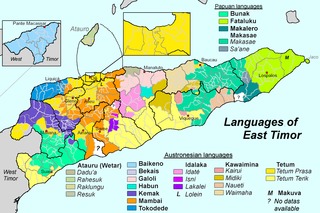Atauran is an Austronesian language spoken on Atauro island and in Manatuto Municipality, East Timor.[2][3] It is closely related to Wetarese and Galoli.
| Atauran | |
|---|---|
| Native to | East Timor |
| Region | Atauro, Manatuto |
Native speakers | 7,900 (2015)[1] |
Austronesian
| |
| Dialects |
|
| Official status | |
Recognised minority language in | |
| Language codes | |
| ISO 639-3 | Atauran |
 | |
Dialects
editAtauran has three main dialects spoken on Atauro:[4]
- Rasua in the sucos Beloi and Biqueli.
- Raklungu in the suco Macadade.
- Hresuk in the suco Maquili.
A fourth variety, Dadu'a, is spoken in Manatuto Municipality on the East Timorese mainland. It is somewhat divergent from the Atauro varieties and has undergone strong influence from Galoli.[5]
Adabe "language"
editThe Raklungu dialect of Atauran, or Kluʼun Hahan Adabe, was mistaken for a Papuan language by Antonio de Almeida (1966) and reported as "Adabe" in Wurm & Hattori (1981).[6] Many subsequent sources propagated this error, showing a Papuan language on Atauro Island.[a] Geoffrey Hull, director of research for the Instituto Nacional de Linguística in East Timor, describes only Wetar varieties being spoken on Ataúro Island, and was unable to find any evidence of a non-Austronesian language there.[2]
Notes
edit- ^ The 2013 edition of Ethnologue, for example, showed "Adabe" being spoken on central Atauro, in the area of Raklungu, and lists the population of all three dialects of Atauran as being Papuan Adabe.
References
edit- ^ Atauran at Ethnologue (27th ed., 2024)
- ^ a b Hull, Geoffrey (2002), The Languages of East Timor: Some Basic Facts (PDF), Instituto Nacional de Linguística, Universidade Nacional de Timor Lorosa'e
- ^ Boarccaech, Alessandro (2020). "Spirits Live Among Us: Mythology, the Hero's Journey, and the Supernatural World in a Community in Ataúro". In Lia Kent; Rui Feijo (eds.). The Dead as Ancestors, Martyrs, and Heroes in Timor-Leste. Amsterdam: Amsterdam University Press. pp. 91–114. doi:10.1515/9789048544448-006.
- ^ Boarccaech, Alessandro (2013). A diferença entre os iguais. São Paolo: Porto de Idéias.
- ^ Miller, Kirk (2019). ISO 639-3 Registration Authority: Request for Change to ISO 639-3 Language Code.
- ^ Wurm, S. A.; Hattori, S. (1981). Language atlas of the Pacific area, part 1 and 2. Pacific Linguistics, Series C, 66 and 67. Canberra: Australian National University.
External links
edit